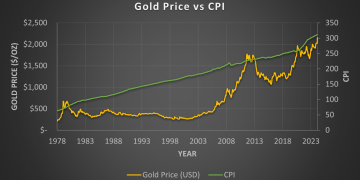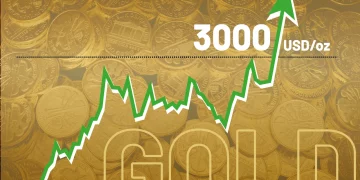Gold has long been considered a safe haven for investors, a store of value during times of economic instability and a reliable hedge against inflation. However, one of the challenges gold investors face is the daily volatility of its price. With price fluctuations often driven by a variety of factors—ranging from geopolitical events to changes in market sentiment—how should investors respond to this short-term volatility? Should they react impulsively to every price shift, or should they stick to their long-term investment strategies? This article explores how to interpret and react to daily gold price fluctuations, and offers strategies to stay on course while navigating the ups and downs of the gold market.
Interpreting Short-Term Volatility for Long-Term Goals
Gold is often seen as a long-term investment. Its value tends to appreciate over extended periods, often during times of inflation or economic uncertainty. However, it is also subject to short-term price movements, which can be unsettling for investors. In fact, daily fluctuations in the price of gold can be influenced by numerous factors including changes in the US dollar, global interest rates, geopolitical tensions, and market speculation.
1. Volatility as a Natural Part of the Market
The first step in responding to daily price fluctuations is recognizing that volatility is a natural part of the gold market—and any market, for that matter. Gold is no exception when it comes to being impacted by real-time data and global events. For instance, political instability in major economies, such as the United States or China, can prompt sudden spikes in gold prices, while positive economic reports can cause declines.
It’s essential to understand that these fluctuations are often temporary and do not necessarily reflect the long-term value of gold as an investment. History has shown that gold tends to perform well over time, particularly when global economies face uncertainties, making it an attractive asset for long-term portfolio diversification.
2. Price Volatility vs. Long-Term Investment Strategies
When it comes to gold, short-term price movements shouldn’t necessarily dictate your investment decisions. Instead, it’s important to keep your long-term financial goals in mind. For instance, if your objective is to use gold as a hedge against inflation or currency devaluation, the daily fluctuations in price should not overly concern you. Gold’s value is largely driven by macroeconomic factors like inflation rates, interest rates, and geopolitical risks, which unfold over time rather than within the span of a few hours or days.
The key takeaway is this: don’t let daily volatility sway you from your investment strategy. If your long-term objective is to hold gold as a store of value, it may be wise to ignore the daily price fluctuations and focus instead on the broader trends. Keep in mind that short-term price swings are often driven by market sentiment rather than intrinsic value, which is more stable over longer periods.
Real-Time Data vs. Patient Investing Strategies
In today’s fast-paced, information-driven environment, investors have access to a wealth of real-time data—gold price charts, news outlets, and market sentiment reports are just a click away. However, while this data can be useful for making quick decisions, it can also lead to impulsive behavior if investors aren’t careful.
1. The Pitfalls of Overreacting to Real-Time Data
While real-time data can provide valuable insights into market sentiment, relying solely on these fluctuations can result in knee-jerk reactions that are detrimental to your long-term portfolio. For instance, an unexpected event, such as an interest rate hike or a geopolitical crisis, may trigger a temporary rise in gold prices. If an investor reacts too quickly by purchasing gold, they may find themselves overpaying for an asset that could quickly lose value once the immediate event passes.
In a similar vein, if the gold price drops temporarily due to a positive economic report or a shift in investor sentiment, panicking and selling off your holdings can lock in losses. These actions, driven by short-term data, can significantly disrupt the long-term value and performance of your investment.
2. The Benefits of Patient Investing
Patient investing is about staying the course and allowing your gold holdings to appreciate over time. Rather than being swayed by short-term noise, a patient investor focuses on the broader economic and market trends that tend to drive gold prices in the long run.
By sticking to your investment strategy, such as holding gold for inflation protection or diversification, you will likely avoid the temptation to react to daily fluctuations. Historical data shows that investors who maintain a steady, long-term approach to gold investing tend to see more favorable returns than those who try to time the market based on short-term price movements.
For those looking to mitigate risks, dollar-cost averaging (DCA) can be an effective strategy, ensuring that purchases are spread out over time, reducing the impact of short-term volatility on the overall investment.
Dollar-Cost Averaging, Hedging, and Exit Timing
Investing in gold doesn’t require you to buy large amounts all at once. There are several strategies available to investors that allow them to weather short-term price fluctuations while still benefiting from gold’s long-term potential.
1. Dollar-Cost Averaging (DCA)
Dollar-cost averaging is one of the most effective strategies to mitigate the impact of market volatility. DCA involves investing a fixed amount of money into gold at regular intervals, regardless of its price at the time of purchase. For example, you might decide to invest $500 in gold each month, regardless of whether the price is high or low.
This strategy allows you to accumulate gold over time without trying to time the market. The benefit of DCA is that it averages out your purchase price over time, so you’re less affected by short-term fluctuations. If the price of gold is low on a given day, your fixed investment will buy more gold; if the price is high, your investment will buy less.
Over the long term, dollar-cost averaging helps smooth out the volatility and reduces the likelihood of making impulsive decisions based on price swings.

2. Hedging with Gold
Hedging is another strategy that can help manage the risk of short-term gold price fluctuations. Many investors use gold as a hedge against economic uncertainty, inflation, or currency devaluation. This means that even if gold prices are volatile in the short term, the overall purpose of holding gold—protection against financial instability—remains intact.
For those who are specifically concerned about gold’s volatility, some investors choose to hedge their positions by diversifying into other asset classes or holding different types of gold, such as physical gold, gold ETFs, or gold mining stocks. This diversification can provide more stability and reduce the impact of daily price fluctuations on a portfolio.
3. Exit Timing: When to Sell Gold
Knowing when to sell gold is an essential aspect of long-term investment strategy, but timing the market can be challenging. For most investors, the decision to sell should be based on changes in their long-term financial goals or portfolio objectives rather than short-term price movements.
For example, if gold prices surge due to a temporary geopolitical event, it might be tempting to sell. However, unless the event marks a structural shift in the global economy, gold prices may revert to their previous levels once the situation stabilizes. Instead of reacting to these short-term spikes, consider whether the price increase fits within your long-term investment strategy.
Some investors also use exit strategies such as setting target prices or trailing stop orders to lock in profits when gold reaches a certain price point. These tools allow investors to automate their sell decisions based on specific criteria, reducing the likelihood of emotional decisions.
Using Price Tools for Smarter Decisions
To make informed decisions and avoid reacting emotionally to market fluctuations, investors can use a variety of tools and resources to track gold prices and market trends. Many financial platforms offer real-time data, price charts, and technical indicators that can help you analyze gold price movements.
1. Price Charts and Technical Indicators
Gold price charts and technical indicators such as moving averages, the Relative Strength Index (RSI), and Bollinger Bands can help you identify trends and make more informed decisions. For example, if gold is in an uptrend but is currently experiencing a short-term pullback, technical indicators can help you determine whether the price is likely to resume its upward movement or if it’s time to exit.
2. Gold Price Alerts
Price alert tools allow you to set automatic notifications when gold hits a specific price target. This can help you take advantage of favorable buying or selling opportunities without constantly monitoring the market. Alerts ensure that you don’t miss important price movements while helping you avoid emotional reactions to short-term price fluctuations.
3. Fundamental Analysis
Along with technical indicators, fundamental analysis can help you understand the underlying factors driving gold prices. Keeping an eye on macroeconomic factors such as inflation rates, interest rates, and central bank policies can give you valuable insight into whether gold prices are likely to rise or fall in the coming months.
Conclusion
Gold price fluctuations can be unsettling for investors, but they don’t have to dictate your investment strategy. By interpreting short-term volatility within the context of long-term goals, using strategies such as dollar-cost averaging, and relying on data and tools to make informed decisions, you can weather the ups and downs of the market with confidence. The key is to remain patient, stay informed, and stick to a strategy that aligns with your financial objectives. By doing so, you’ll be better equipped to navigate the ever-changing landscape of the gold market and make smarter, more strategic decisions over time.




































